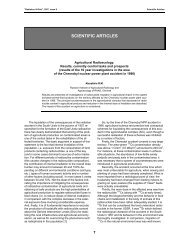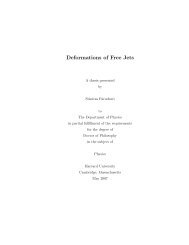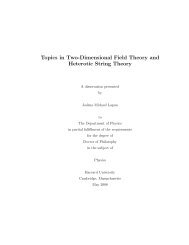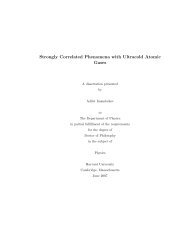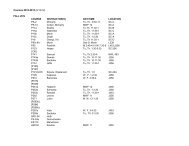Solution Week 46 (7/28/03) The birthday problem (a) Given n people ...
Solution Week 46 (7/28/03) The birthday problem (a) Given n people ...
Solution Week 46 (7/28/03) The birthday problem (a) Given n people ...
Create successful ePaper yourself
Turn your PDF publications into a flip-book with our unique Google optimized e-Paper software.
<strong>Solution</strong><br />
<strong>Week</strong> <strong>46</strong> (7/<strong>28</strong>/<strong>03</strong>)<br />
<strong>The</strong> <strong>birthday</strong> <strong>problem</strong><br />
(a) <strong>Given</strong> n <strong>people</strong>, the probability, Pn, that there is not a common <strong>birthday</strong><br />
among them is<br />
�<br />
Pn = 1 − 1<br />
� �<br />
1 −<br />
365<br />
2<br />
� � �<br />
n − 1<br />
· · · 1 − . (1)<br />
365<br />
365<br />
<strong>The</strong> first factor is the probability that two given <strong>people</strong> do not have the same<br />
<strong>birthday</strong>. <strong>The</strong> second factor is the probability that a third person does not<br />
have a <strong>birthday</strong> in common with either of the first two. This continues until<br />
the last factor is the probability that the nth person does not have a <strong>birthday</strong><br />
in common with any of the other n − 1 <strong>people</strong>.<br />
We want Pn < 1/2. If we simply multiply out the above product with successive<br />
values of n, we find that P22 = .524, and P23 = .493. <strong>The</strong>refore, there<br />
must be at least 23 <strong>people</strong> in a room in order for the odds to favor at least<br />
two of them having the same <strong>birthday</strong>.<br />
Remark: This answer of n = 23 is much smaller than most <strong>people</strong> expect, so it<br />
provides a nice betting opportunity. For n = 30, the odds of a common <strong>birthday</strong><br />
increase to 70.6%, and most <strong>people</strong> still find it hard to believe that among 30 <strong>people</strong><br />
there are probably two who have the same <strong>birthday</strong>. <strong>The</strong> table below lists various<br />
values of n and the probabilities, 1 − Pn, that at least two <strong>people</strong> have a common<br />
<strong>birthday</strong>.<br />
n 10 20 23 30 50 60 70 100<br />
1 − Pn 11.7% 41.1% 50.7% 70.6% 97.0% 99.4% 99.92% 99.9994%<br />
Even for n = 50, most <strong>people</strong> would be happy to bet, at even odds, that no two<br />
<strong>people</strong> have the same <strong>birthday</strong>. If they seem a bit hesitant, however, you can simply<br />
offer them the irrefusable odds of 10 to 1. (That is, you put down, for example, $10<br />
on the table, and they put down $1. If there is a common <strong>birthday</strong>, you take all the<br />
money. If there is no common <strong>birthday</strong>, they take all the money.) Since there is a<br />
97.0% chance of a common <strong>birthday</strong> among 50 <strong>people</strong>, a quick calculation shows that<br />
you will gain, on average, 67 cents for every $10 you put down.<br />
One reason why many <strong>people</strong> do not believe the n = 23 answer is correct is that they<br />
are asking themselves a different question, namely, “How many <strong>people</strong> need to be<br />
present for there to be a 1/2 chance that someone else has my <strong>birthday</strong>?” <strong>The</strong> answer<br />
to this question is indeed much larger than 23. <strong>The</strong> probability that no one out of n<br />
<strong>people</strong> has a <strong>birthday</strong> on a given day is (1 − 1/365) n . For n = 252, this is just over<br />
1/2. And for n = 253, it is just under 1/2. <strong>The</strong>refore, you need to come across 253<br />
other <strong>people</strong> in order to expect that at least one of them has your <strong>birthday</strong>.<br />
(b) First <strong>Solution</strong>: <strong>Given</strong> n <strong>people</strong>, and given N days in a year, the reasoning in<br />
part (a) shows that the probability that no two <strong>people</strong> have the same <strong>birthday</strong><br />
is<br />
Pn =<br />
�<br />
1 − 1<br />
� �<br />
1 −<br />
N<br />
2<br />
� �<br />
· · · 1 −<br />
N<br />
1<br />
�<br />
n − 1<br />
. (2)<br />
N
If we take the natural log of this equation and use the expansion,<br />
then the requirement Pn ≤ 1/2 becomes<br />
�<br />
1<br />
−<br />
N<br />
+ 2<br />
N<br />
Using the sums,<br />
ln(1 − x) = −(x + x 2 /2 + · · ·), (3)<br />
�<br />
n − 1<br />
+ · · · −<br />
N<br />
1<br />
�<br />
1<br />
2 N<br />
n�<br />
k =<br />
1<br />
n(n + 1)<br />
2<br />
we can rewrite eq. (4) as<br />
n(n − 1)<br />
2N<br />
, and<br />
4 (n − 1)2<br />
+ + · · · 2 N 2 N 2<br />
n�<br />
k<br />
1<br />
2 =<br />
�<br />
n(n + 1)(2n + 1)<br />
6<br />
− · · · ≤ − ln 2. (4)<br />
, (5)<br />
n(n − 1)(2n − 1)<br />
+<br />
12N 2 + · · · ≥ ln 2. (6)<br />
For large N, the first term will be of order 1 when n ≈ √ N, in which case<br />
the second- and higher-order terms are negligible. <strong>The</strong>refore, keeping only the<br />
first term (which behaves like n 2 /2N), we find that Pn is equal to 1/2 when<br />
Let’s look at a few cases:<br />
n ≈ √ 2 ln 2 √ N. (7)<br />
• For N = 365, eq. (7) gives n = 22.5. Since we must have an integral<br />
number of <strong>people</strong>, this agrees with the exact result, n = 23.<br />
• For N = 24 · 365 = 8760 (that is, for births in the same hour), we find<br />
n = 110.2. This agrees with the exact result, n = 111, obtained by<br />
multiplying out eq. (2).<br />
• For N = 60 · 24 · 365 = 525, 600 (that is, for births in the same minute),<br />
we find n = 853.6. This agrees with the exact result, n = 854, obtained<br />
by multiplying out eq. (2) (not by hand!). This is a very small number<br />
compared to the more than half a million minutes in a year.<br />
Remarks:<br />
(1) If we wish to ask how many <strong>people</strong> need to be in a room in order for the<br />
probability to be at least p that some two have the same <strong>birthday</strong>, then the<br />
above derivation is easily modified to yield<br />
n ≈<br />
�<br />
2 ln( 1<br />
1−p )√ N. (8)<br />
(2) <strong>The</strong> alternative question introduced in part (a), “How many <strong>people</strong> need to be<br />
present for there to be a 1/2 chance that someone else has my <strong>birthday</strong>?”, may<br />
also be answered in the large-N limit. <strong>The</strong> probability that no one out of n<br />
<strong>people</strong> has a <strong>birthday</strong> on a given day is<br />
�<br />
1 − 1<br />
�n �<br />
= 1 −<br />
N<br />
1<br />
�N(n/N) ≈ e<br />
N<br />
−n/N . (9)<br />
2
<strong>The</strong>refore, if n > N ln 2, you can expect that at least one of the n <strong>people</strong> has<br />
your <strong>birthday</strong>. For N = 365, we find that N ln 2 is slightly less than 253, so<br />
this agrees with the result obtained in part (a). Note that this result is linear in<br />
N, whereas the result of the original <strong>problem</strong> in eq. (7) behaves like √ N. <strong>The</strong><br />
reason for this square-root behavior can be seen in the next solution.<br />
Second <strong>Solution</strong>: <strong>Given</strong> a large number, n, of <strong>people</strong>, there are �n� =<br />
2<br />
n(n − 1)/2 ≈ n2 /2 pairs of <strong>people</strong>. <strong>The</strong> probability that a given pair has<br />
the same <strong>birthday</strong> is 1/N, so the probability that they do not have the same<br />
<strong>birthday</strong> is 1 − 1/N. 1 <strong>The</strong>refore, the probability that no pair has a common<br />
<strong>birthday</strong> is<br />
Pn =<br />
This equals 1/2 when<br />
in agreement with eq. (7).<br />
�<br />
1 − 1<br />
�n2 /2 �<br />
≈ 1 −<br />
N<br />
1<br />
�N(n2 /2N)<br />
≈ e<br />
N<br />
−n2 /(2N)<br />
. (10)<br />
n ≈ √ 2 ln 2 √ N. (11)<br />
Remark: We assumed above that all the pairs are independent, as far as writing<br />
down the 1 − 1/N probability goes. Let us now show that this approximately true.<br />
We will show that for large N and n, the assumptions on the coincidence of <strong>birthday</strong>s<br />
in some pairs do not significantly affect the probability of coincidence in other pairs.<br />
More precisely, the relation Pn ≈ e −n2 /(2N) is true if n ≪ N 2/3 . <strong>The</strong> reasoning is as<br />
follows.<br />
Consider n <strong>people</strong> and N days in a year. Assumptions on the coincidence of <strong>birthday</strong>s<br />
in some pairs will slightly affect the probability of coincidence in other pairs, because<br />
the given assumptions restrict the possible <strong>birthday</strong>s of these other pairs. For example,<br />
if it is given that A and B do not have the same <strong>birthday</strong>, and also that B and C do<br />
not, then the probability that A and C do not have the same <strong>birthday</strong> is 1 − 1/364<br />
(instead of 1 − 1/365), because they are both restricted from having a <strong>birthday</strong> on<br />
B’s <strong>birthday</strong>, whatever it may be.<br />
<strong>The</strong> maximal restriction that can be placed on the possible <strong>birthday</strong>s of a given pair<br />
occurs when it is known that neither of them has a <strong>birthday</strong> in common with any of<br />
the other n − 2 <strong>people</strong>. In this case, the possible <strong>birthday</strong>s for the last two <strong>people</strong> are<br />
restricted to N − (n − 2) days of the year. <strong>The</strong>refore, the probability that the last<br />
pair does not have a common <strong>birthday</strong> is 1 − 1/(N − n + 2) > 1 − 1/(N − n). This is<br />
the most that any such probability can differ from the naive 1 − 1/N. <strong>The</strong>refore, we<br />
may say that<br />
�<br />
1 − 1<br />
� 2<br />
n /2<br />
N − n<br />
≤ Pn ≤<br />
�<br />
1 − 1<br />
� 2<br />
n /2<br />
N<br />
=⇒ e −n2 /2(N−n) ≤ Pn ≤ e −n2 /(2N) . (12)<br />
<strong>The</strong> ratio of these upper and lower bounds on Pn is<br />
�<br />
exp − n2<br />
2N +<br />
n2 � �<br />
n<br />
= exp<br />
2(N − n)<br />
3 �<br />
. (13)<br />
2N(N − n)<br />
1 This is not quite correct for all the pairs, because two pairs are not independent if, for example,<br />
they share a common person. But it is accurate enough for our purposes in the large-N limit. See<br />
the remark below.<br />
3
For large N, this ratio is essentially equal to 1, provided that n ≪ N 2/3 . <strong>The</strong>refore,<br />
Pn ≈ e −n2 /(2N) if n ≪ N 2/3 . And since the result in eq. (11) is in this realm, it is<br />
therefore valid.<br />
Extension: We can also ask the following question: How many <strong>people</strong> must<br />
be in a room in order for the probability to be greater than 1/2 that at least b<br />
of them have the same <strong>birthday</strong>? (Assume that there is a very large number,<br />
N, of days in a year, and ignore effects that are of subleading order in N.)<br />
We can solve this <strong>problem</strong> in the manner of the second solution above. <strong>Given</strong><br />
a large number, n, of <strong>people</strong>, there are �n� b groups of b <strong>people</strong>. This is approximately<br />
equal to nb /b! (assuming that b ≪ n).<br />
<strong>The</strong> probability that a given group of b <strong>people</strong> all have the same <strong>birthday</strong><br />
is 1/N b−1 , so the probability that they do not all have the same <strong>birthday</strong> is<br />
1 − (1/N b−1 ). 2 <strong>The</strong>refore, the probability, P (b)<br />
n , that no group of b <strong>people</strong> all<br />
have the same <strong>birthday</strong> is<br />
This equals 1/2 when<br />
Remarks:<br />
P (b)<br />
�<br />
n ≈ 1 − 1<br />
N b−1<br />
�nb /b!<br />
≈ e −nb /b!N b−1<br />
. (14)<br />
n ≈ (b! ln 2) 1/b N 1−1/b . (15)<br />
(1) Eq. (15) holds in the large-N limit. If we wish to make another approximation,<br />
that of large b, we see that the quantity (b! ln 2) 1/b goes like b/e, for large b. (This<br />
follows from Sterling’s formula, m! ≈ m m e −m√ 2πm.) <strong>The</strong>refore, for large N,<br />
n, and b (with b ≪ n ≪ N), we have P (b)<br />
n = 1/2 when<br />
n ≈ (b/e)N 1−1/b . (16)<br />
(2) <strong>The</strong> right-hand side of equation eq. (15) scales with N according to N 1−1/b .<br />
This means that if we look at the numbers of <strong>people</strong> needed to have a greater<br />
than 1/2 chance that pairs, triplets, etc., have common <strong>birthday</strong>s, we see that<br />
these numbers scale like<br />
N 1/2 , N 2/3 , N 3/4 , · · · . (17)<br />
For large N, these numbers are multiplicatively far apart. <strong>The</strong>refore, there are<br />
values of n for which we can say, for example, that we are virtually certain that<br />
there are pairs and triplets with common <strong>birthday</strong>s, but also that we are virtually<br />
certain that there are no quadruplets with a common <strong>birthday</strong>. For example, if<br />
n = N 17/24 (which satisfies N 2/3 < n < N 3/4 ), then eq. (14) shows that the<br />
1 1/8<br />
− 6 N<br />
probability that there is a common <strong>birthday</strong> triplet is 1 − e ≈ 1, whereas<br />
1 −1/6<br />
− the probability that there is a common <strong>birthday</strong> quadruplet is 1 − e 24 N ≈<br />
1<br />
24 N −1/6 ≈ 0.<br />
2 Again, this is not quite correct, because the groups are not all independent. But I believe it is<br />
accurate enough for our purposes in the large-N limit. I have a proof which I think is correct, but<br />
which is very ugly. If anyone has a nice clean proof, let me know.<br />
4



